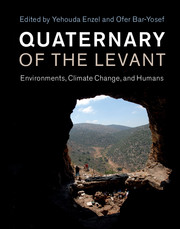Book contents
- Quaternary of the Levant
- Quaternary of the Levant
- Copyright page
- Contents
- Contributors
- Acknowledgements
- 1 The Quaternary of the Levant
- Part I: The Evolution of Current Landscapes and Basins
- Part II: Palaeoclimates
- 8 Chronologies of Late Quaternary Coral Reefs and Lake Sediments from the Red Sea and Dead Sea Rift Valley
- 9 Sedimentology of the Lacustrine Formations in the Dead Sea Basin
- 10 The Amora Formation, Dead Sea Basin
- 11 The Stratigraphy and Chronology of the Samra Formation
- 12 Lake Lisan
- 13 Dead Sea Lake Level Changes and Levant Palaeoclimate
- 14 Pliocene–Pleistocene Water Bodies and Associated Deposits in Southern Israel and Southern Jordan
- 15 Quaternary Evolution of Caves and Associated Palaeoenvironments of the Southern Levant
- 16 Geoarchaeology of Levantine Prehistoric Caves
- 17 Climate and Environment Reconstructions Based on Speleothems from the Levant
- 18 Speleothems from Lebanon
- 19 Late Quaternary Palaeoenvironments in Northern Levant (Lebanon and Syria)
- Part III: Archaeology of Human Evolution
- Part IV: Palaeoecology
- Part V: Quaternary Geomorphology
- Part VI: Humans in the Levant
- Index
- Plate section
- References
8 - Chronologies of Late Quaternary Coral Reefs and Lake Sediments from the Red Sea and Dead Sea Rift Valley
from Part II: - Palaeoclimates
Published online by Cambridge University Press: 04 May 2017
- Quaternary of the Levant
- Quaternary of the Levant
- Copyright page
- Contents
- Contributors
- Acknowledgements
- 1 The Quaternary of the Levant
- Part I: The Evolution of Current Landscapes and Basins
- Part II: Palaeoclimates
- 8 Chronologies of Late Quaternary Coral Reefs and Lake Sediments from the Red Sea and Dead Sea Rift Valley
- 9 Sedimentology of the Lacustrine Formations in the Dead Sea Basin
- 10 The Amora Formation, Dead Sea Basin
- 11 The Stratigraphy and Chronology of the Samra Formation
- 12 Lake Lisan
- 13 Dead Sea Lake Level Changes and Levant Palaeoclimate
- 14 Pliocene–Pleistocene Water Bodies and Associated Deposits in Southern Israel and Southern Jordan
- 15 Quaternary Evolution of Caves and Associated Palaeoenvironments of the Southern Levant
- 16 Geoarchaeology of Levantine Prehistoric Caves
- 17 Climate and Environment Reconstructions Based on Speleothems from the Levant
- 18 Speleothems from Lebanon
- 19 Late Quaternary Palaeoenvironments in Northern Levant (Lebanon and Syria)
- Part III: Archaeology of Human Evolution
- Part IV: Palaeoecology
- Part V: Quaternary Geomorphology
- Part VI: Humans in the Levant
- Index
- Plate section
- References
Summary
- Type
- Chapter
- Information
- Quaternary of the LevantEnvironments, Climate Change, and Humans, pp. 75 - 82Publisher: Cambridge University PressPrint publication year: 2017
References
- 1
- Cited by

